Table of Contents:
1. A Background
2. Red Bull to Red Bull Media House
- A Content King
- I Can’t Stop Sharing. Can You?
3. Red Bull Media House
- Art of Flight
- Stratos – Involvement, What if Things Had Gone Wrong?, $30M: Now What?
- The World of Red Bull App
A BACKGROUND
A handful of the best ice-hockey players in the world race their way down a steep ice track with thousands of people watching. A documentary film on legendary snowboarders and their journey to discover extreme winter-sports locations generates 10 million trailer views. One man jumps from a stratospheric balloon 128,100 feet in the sky and free falls for 4 minutes and 22 seconds at 883mph. Nokia gets involved to bring the latest technology for content customization applications on mobile.
Red Bull has come a long way. Founded in 1984 by Dietrich Mateschitz, Red Bull was spun off as a “fine-tuned tonic drink” in the Austrian market. Now a global company present in 164 countries, Red Bull is a lot more than just the energy drink they were created to produce. The above is only a taste of what their marketing genius dives into, and social media is the backbone to support it all.
Many brands have the ultimate goal of becoming a media company and leveraging themselves ubiquitously through multiple channels but few have actually committed. In 2007, Red Bull Media House launched in Salzburg, Austria and has since become one of the world’s leading media companies. Red Bull Media House managing director calls it a “natural revolution” where success is in how you market the product as much as the product itself. It’s difficult to specifically pinpoint the exact moment when CEO Dietrich Mateschitz decided that marketing would play the main role in the Red Bull brand, but a few things are definite.
RED BULL IS A CONTENT KING. Here’s a sample:
A Canadian snowboarder’s story on his rise to fame started all when he won a contest at 13 years old.
“Sebastien Toutant Documentary: The Canadian Snowboarder Reveals How It All Began”
Featured on a newsfeed format are countless videos on challenges, events, and most importantly, people. The content consistently reminds us that any of these professional extreme sports athletes are people just like us. They all “speak” for the brand, in that “Red Bull gives you wings” to accomplish anything you want in life. Any of these inspiring videos can be shared via Facebook or Twitter and clicking on an individual video directs you to a blog format that invites comments from readers.
My favorite content on the website is “just epic.” It’s simply a collection of record breaking, extreme challenge video footage you probably won’t see or find anywhere else. This tab on the website really showcases how Red Bull has teamed up with star film makers to capture and edit full-action footage. Where else could you experience Felix’s record-breaking jump?
Indeed worthy of a “holy shit.” If you’re really interested in the content you happen to stumble upon, the right side conveniently features “related content” for further exploration. Furthermore, Red Bull is not just all about extreme sports or the energy drink. As with all successful brands, an established community of culture is important. They also feature all kinds of media ranging from dance to gaming.
Red Bull Flying Bach – Break Dancing and… Bach?
Red Bull characterizes their brand through break-through, high action culture. They sponsor unique individuals and help their talents be known. This is among one of many videos on their website that I just can’t stop watching. I have no clue who these people are, but I can’t help but be mesmerized by not only their talents but the art in the video itself. It’s a perfect example of how Red Bull doesn’t just throw some money into a project or sponsorship because they have it, but they truly invest in the full effort to push the best content forward that engages audiences. In this video and many others, it’s all about the cinematography since they are all high action. We want to see those slow-mo’s, we want to see the expressions on people’s faces, we want to see the art. Red Bull is also an expert at picking and creating only the most unique content.
Wakeskating in… a cranberry bog? Done.
I CAN’T STOP SHARING. CAN YOU?
No doubt of one of the things that I find most mind boggling about social media is what makes people share and what makes videos go viral. (Let’s be real, there is some content out there that doesn’t seem to deserve sharing.) But Red Bull seems to have the golden key to this secret–or is it a secret?. All the content and media they share hits “what the researchers in the virality study call emotional valence.” On the featured axis below, you’ve got “anger, happiness, relaxation and sadness.” Anger and happiness are considered “positive,” indicating what tends to get shared online while relaxation and sadness do not. The higher the content lies on the anger or happiness axes, the more likely it is to be shared. 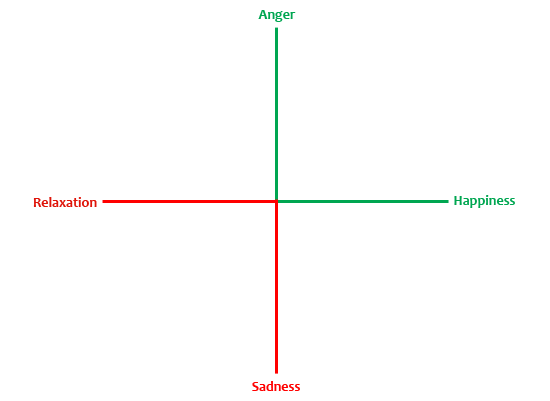 The study indicates “People want to be surprised and shocked… And almost universally, people want to laugh.” Well, Red Bull sure knows how to surprise and shock people. Take a look at what’s being shared on @RedBull (and it’s not just content):
The study indicates “People want to be surprised and shocked… And almost universally, people want to laugh.” Well, Red Bull sure knows how to surprise and shock people. Take a look at what’s being shared on @RedBull (and it’s not just content):
An episode of “Red Bull Rampage – unforgiving, scary, treacherous – and the best event of the year for freeride mountain bikers.”
Daring, inquisitive, inspiring: All of which speak for the brand, and the people that follow it.
RED BULL MEDIA HOUSE
As Red Bull’s content arm, “Red Bull Media House is a multi-platform media company with a focus on sports, culture and lifestyle.” Their products are in print, TV, online, music, mobile, games and cinema. They also commit to content licensing and brand partnerships. Some of their most successful social media marketing initiatives:
ART OF FLIGHT
An epitome of social media integration in film marketing, the documentary, sponsored by Red Bull in partnership with Brain Farm Digital Cinema (specializing in aerial cinematography) “gives iconic snowboarder Travis Rice and friends the opportunity to redefine what is possible in the mountains.” The film was highly successful in sales on iTunes and the trailer yielded >11k YouTube views, in addition to >130k fans on Facebook. @artofFLIGHT also has >10,000 followers on Twitter.
Gamification as Promotion:
Accompanying the film is an online game where you can use your keyboard to control flips, spins and jumps on a snowboarder along the Alps, Alaska and Patagonia. The goal is to get the highest score by doing the most tricks and the game allows you to challenge/race friends via Twitter and Facebook. The game is a good way to pass off boredom but is quite limited. However, this additional feature doesn’t hurt their promotion.
RED BULL STRATOS
Red Bull’s space diving project involving Felix Baumgartner, an Austrian skydiver who flew 24 miles into space on a stratospheric balloon over New Mexico, US on October 14th, 2012 and free-fell for 4 minutes and 19 seconds before parachuting back to earth. Their overall mission is “to advance scientific discoveries in aerospace for the benefit of mankind.”
How involved they were:
1. Updates and ubiquity: One look at @RedBullStratos feed for October 14th and I was pretty much sold. It was so updated and anyone could follow the feed and feel like they were there. I know I did. “Felix is entering the capsule for pre-breathing. Felix enters the capsule. Felix goes over a checklist with Joe Kittinger back in mission control. Weather hold is lifted and the balloon is now being inflated.”–etc, etc, etc. Someone was definitely manning the twitter handle and updating second by second–which seems like a no-brainer when you have this big of an event happening and representing your brand, but I am surprised by how many companies fail to invest the time and effort necessary (there’s not even $$$ involved here..). Active monitoring is mandatory in every successful social media strategy. Another glance at their feed for the day shows me that they really, really, REALLY wanted EVERYONE watching the live jump and they made the link very accessible. Almost all tweets linked the live broadcast, so even if you had never followed them before, you were bound to see what was going on.
2. In case you were wondering: Red Bull Stratos pretty much covered all bases. It seems that every nitty-gritty detail about the mission that you could possibly want to learn was present, somewhere either in their website or accessible via Twitter–you know, just in case you cared about how big the stratospheric balloon was in comparison to the Statue of Liberty. 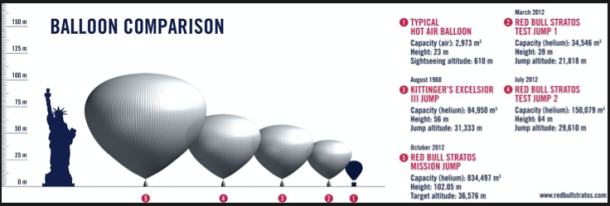 The website allows us to become informed “scientists” on the mission and discusses aeronautical records, the speed of sound, the atmosphere and scientific value, among many other things. Detailed diagrams show the pressure suit, the capsule, the high altitude balloon and more. No matter what fascinated you about the mission, it was probably all there: in text, diagram or media.
The website allows us to become informed “scientists” on the mission and discusses aeronautical records, the speed of sound, the atmosphere and scientific value, among many other things. Detailed diagrams show the pressure suit, the capsule, the high altitude balloon and more. No matter what fascinated you about the mission, it was probably all there: in text, diagram or media.
3. They hear you: This is admirable. They generate interaction and engagement through being genuine. They give the chance to ask questions and they listen by answering them. Chosen questions for Felix tweeted @RedBullStratos were answered live at the press conference. This video of a good luck song for Felix was tweeted out, retweeted over 200 times and got >27k views on YouTube.
What if things had gone wrong?
To be honest, there’s next to nothing on what would have happened to Red Bull if things had gone wrong but I think we can paint a clear, disturbing picture. The cost of damages: priceless. The severity would no doubt take down Red Bull, probably for good or at least a long, long time. It could damage their brand image forever and as marketers all know: Brand image building takes years, and possibly decades. However, this emphasizes the amount of preparation, time and money-wise that goes into a project such as this one.
The mission planning started 7 years ago, and dozens of supportive personnel had to be on board. Among Felix’s coaches was Jonathan Clark, M.D. the Red Bull Stratos medical director. “One of the most distinguished names in aerospace medicine,” Jonathan Clark was a space shuttle crew surgeon for 8 years at NASA before serving 26 years with the U.S. Navy. His vital roles in the mission include protecting Felix from the physical dangers of high altitude of course and “establishing new protocols for the benefit of future aviators and astronauts.” National Geographic points out some of the scariest things that could have happened to Felix, from the wind blowing him off course to depressurization at extreme altitude resulting in immediate death after his blood literally boils.
$30M, NOW WHAT?
Forbes estimates the cost of the mission to be $30M, although “Red Bull hasn’t given details on the cost….” If the investment was a whopping $30M, what was their ROI? “…another Forbes columnist projects it to be worth tens of millions of dollars.” Looking at publicity numbers/view count and perhaps more immeasurable details, we can hint at their ROI:
1. “Digital Forensics” – According to YouTube, >8M people watched the live jump. Provided by Social Bakers, two graphs indicate mentions on Twitter and subscriber growth on YouTube, showing high engagement. Both graphs show huge spikes in engagement on October 10th, when the jump was originally scheduled and October 14th when the jump actually happened. Red Bull Stratos experienced an addition of over 87k subscribers on the day of the jump while total mentions on Twitter were >10k.
Further evidence of high engagement lies in the amount of fans Felix generated on his Facebook page– a leap of 570k fans from 10/13/12 to 10/14/12. (Check out that growth!)
People talking about the mission on Facebook: (raw #’s)
Red Bull Stratos and Felix were hot topics of conversation on Facebook, experiencing similar exponential growth between 10/11/12 and 10/12/12. It’s interesting to note that Red Bull experienced declining numbers. This could be due to all the overwhelming attention focused on the mission and diminishing emphasis on Red Bull in general.
People talking about this (PTAT) rate:
Looking at the PTAT rates further exaggerates the % growth of discussion. During this period of time, we can see that Red Bull experiences no growth.
2. “Symbiosis… between brand and subculture” – Fast Company names Red Bull Media House as one of 2012’s “World’s 50 Most Innovative Companies.” The beneficial relationship between Red Bull and extreme sports feeds off each other. Outside Magazine writes that “without Red Bull, it’s unlikely the extreme-sports boom would have happened at all.” Red Bull sponsors so many extreme sports athletes, providing publicity and media for them and making their stories known. The brand has not only become a media company but a catalyst in something much bigger– a revolution that spurred for a particular community. Digital Organics confirms, “What makes a brand stand out is how it transforms an audience into a community.” This sustains and supports long-term growth for the brand. Forbes sums it up well: “The sponsorship transcended sports and entertainment into Pop Culture, hitting new consumers that Red Bull does not usually capture, and on a global scale…The value for Red Bull is in the tens of millions of dollars of global exposure, and Red Bull Stratos will continue to be talked about and passed along socially for a very long time.” Felix’s stunt may be something Red Bull is now and later known for and you can’t put a price on that.
3. “I love everything about Red Bull… except the drink.”  This comment I spotted on the Wakeskating YouTube video posted above sparked much further thought because I found so much truth in it. I’m not sure how many of you are true fans of the energy drink itself, but I know a few people (including myself) that are not too fond of the drink’s taste. I remember myself in disbelief when I learned that people drink Red Bull casually because they enjoy it or that some are even addicted. However, this comment speaks to something much bigger. Red Bull has allowed themselves other multiple outlets for revenue and not just drink sales. Some of this can be attributed to the media business of Red Bull Media House, and some of it to other innovations/possibilities to come. With so much associated with the Red Bull brand from extreme sports to art to a developing mobile application, Red Bull has further increased their value via social media.
This comment I spotted on the Wakeskating YouTube video posted above sparked much further thought because I found so much truth in it. I’m not sure how many of you are true fans of the energy drink itself, but I know a few people (including myself) that are not too fond of the drink’s taste. I remember myself in disbelief when I learned that people drink Red Bull casually because they enjoy it or that some are even addicted. However, this comment speaks to something much bigger. Red Bull has allowed themselves other multiple outlets for revenue and not just drink sales. Some of this can be attributed to the media business of Red Bull Media House, and some of it to other innovations/possibilities to come. With so much associated with the Red Bull brand from extreme sports to art to a developing mobile application, Red Bull has further increased their value via social media.
THE WORLD OF RED BULL APP
Red Bull partners with Nokia to create Red Bull MOBILE, where customers get access to a “mobile portal packed with quality content like music, up-close information on athletes, and offers to money-can’t-buy events.” It’s a way to provide maximum accessibility for fans and keep them engaged. The “My Red Bull” section even allows customization of content, much like how your Twitter feed is customized with tweets of those you choose to follow. It’s undoubtedly a smart move on Red Bull’s part. As a “content king,” why not provide an easily accessible platform to distribute the content?
*All sources linked within text.
Additional stats:
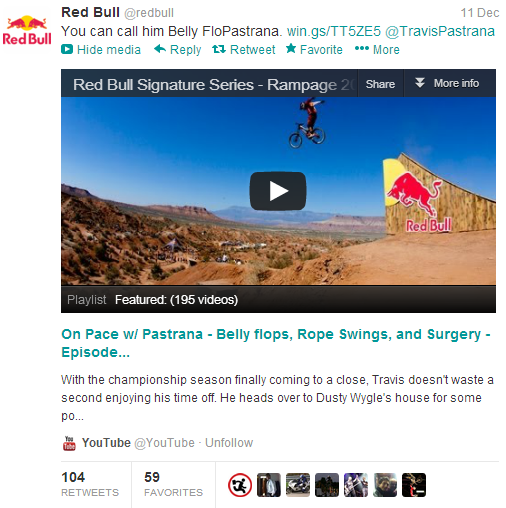

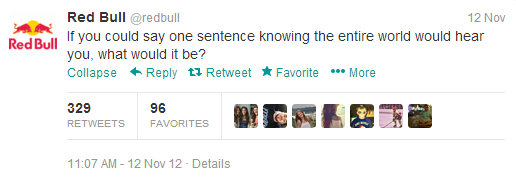


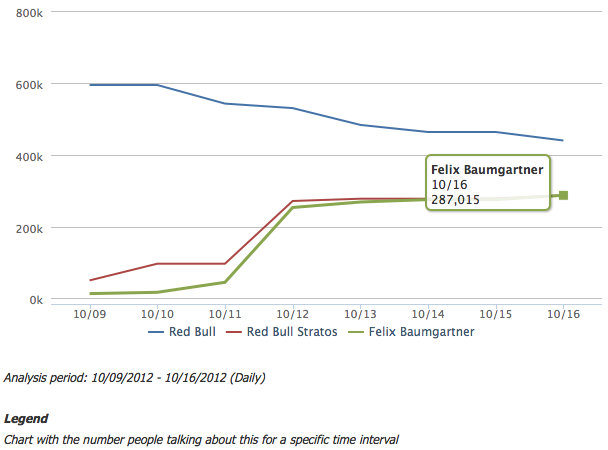
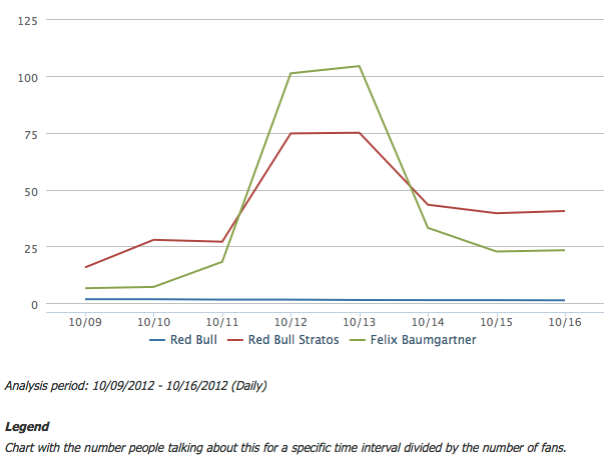
I’ve been addicted to Red Bull’s social media for quite some time and I think the virality study call emotional valence is a perfect way to look at what makes videos and content good. Many people turn to social media to vent because they are angry but I personally relate to the happiness axis and I think that’s where Red Bull falls. Happiness combined with being extremely impressed. One thing that is great about their videos is the cinematography. Everything is so well filmed with great quality. I think it is very hard to determine ROI of such efforts like Stratos because it seems that Red Bull will see most benefits in the long term after a short term burst. I’m sure their brand equity was increased and is increased through much of their social media. They’re not selling a product but rather a culture and their social media shows this. Great final project–I’m glad that you chose Red Bull!
Really well done, liked the embedded content and exploration of both Stratos but also the general theme of Red Bull’s marketing and social media being so inextricably linked to its product’s success. In some sense, they are not just an ‘energy drink company’ but rather an extreme action sports brand that also sells energy drinks. I wonder what people who think these energy drinks are harmful for us think? They probably chafe at the way good marketing/PR can boost Red Bull to new heights (pun intended). Well done – really enjoyed reading the project and viewing the content (the Cranberry Bog video is quite funny – I just never would have thought of that!).
I loved hearing the background story of RedBull; I always understood their slogan “RedBull gives you wings” for its caffeinating effect, but was unaware that it had a direct tie to air travel and jetlag itself. I now feel in the loop! I too am amazed that a beverage company has been able to leverage its brand to enter into the “extreme sports” and media industries. They’re a quintessential example of expanding a brand into complementing sectors, and should be equally respected for it. It’s funny, RedBull almost feels like an entirely separate entity than its competitors like Monster or 5 hour energy. They’ve differentiated themselves so far from just energy drinks that it’s now essentially in the business of “extreme” and “cool” (and also extremely cool) events, sports, and ideas. Also, just saw the Art of Flight a few days ago and its now one of my favorite movies.
I like how you labeled one your points what if things went wrong. That is a great question, what if things went wrong? Then what. Its hard to say what the consequences or repercussions would have been for Red Bull had the jump from space failed. Would they still be as popular or would the negative press have eaten them alive? At the same time I am always thrilled and excited about the things that redbull does. With the space jump there are so many beneficial contributions that the company can now make to science. At the end of the day when there is a positive impact on society and that is something I love to see.
Really interesting read, and I loved checking out all the RedBull media/content. I think what makes these RedBull campaigns successful is the fact that you never see the actual product in their advertising. I would imagine videos of people drinking an energy drink would not be very exciting. Instead, RedBull uses their advertising and social media to entertain consumers and engage them with the RedBull brand. RedBull uses social media to gain a large audience for their events. By doing all of these high-profile extreme sport stunts, RedBull is always in our face. Because of this, most people going to the store for an energy boost will be quick to pick a RedBull off the shelves.
I’m not a marketing major myself, but if I was Red Bull sounds like the place to be for anyone going into the field. I thought the Felix jump was really cool, but one criticism i have that you pointed out was that it was extremely expensive and risky. You point out that the returns came in the form of followers and social media interaction, but it hard to put a value on that and to quantify the value that was added to the brand. As long as people stay interested and no big mistakes occur than Red Bull will continue to succeed and prosper, but it sounds to me like a risky model.
It definitely shows that you’ve done a great amount of research and work into this topic. I really enjoyed reading about Red Bull and their role as a social media powerhouse. I think it’s funny how when I read about Red Bull in your post, I don’t really think about the drink. It’s not like the videos include much of the extremist drinking red bull and then “taking flight”. So now I’m thinking the brand itself is great, it has taken a different approach to a lot of what the competitors in its industry is doing, but personally, I associated the actual drink to a drink that will “get me through finals” or something I enjoyed with vodka. Nonetheless, I still think it’s done a great job in thinking of innovative ways of expressing their brand’s mission through social media. It seems like it’s gotten a lot of attention and a lot of people talking about it. Great job!!!
Great post Patrice. Extremely in depth and I really didnt know about Red Bull Media House before this. I think it is really interesting how CPG companies often need to do something outside of the realm of traditional advertising to enhance their brand and I think you provided a great example of how Red Bull has done this with their natural connection to extreme sports. What I find really interesting is your last point about loving the brand but not the drink. I find this is the case with me as well and I’m sure many others love the connection to extreme sports but are not too fond of the brand. I wonder how this will effect Red Bull’s marketing strategy going forward and whether all of this capital investment is actually turning into purchases or just brand awareness. I think something like energy drinks can be so polarizing so I would be interested to see if this is still Red Bull’s strategy 10 years from now. Great post and topic though!
Good day! Would you mind if I share your blog with
my twitter group? There’s a lot of folks that I think would really appreciate your content. Please let me know. Thank you
Sure, what’s your Twitter handle?